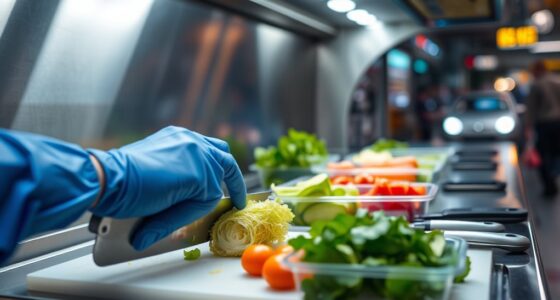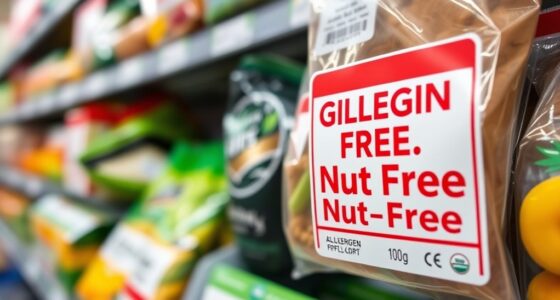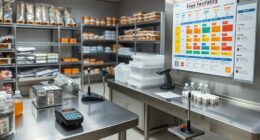As a mobile vendor, you must prioritize personal hygiene by washing hands frequently, wearing protective gear, and sanitizing tools regularly. Store food properly in airtight containers, keeping raw and ready-to-eat items separate, and maintain correct temperatures to prevent bacterial growth. Clean and sanitize all surfaces and equipment often, using proper techniques. Proper handling, cross-contamination prevention, and temperature control are essential. Keep these practices in mind, and you’ll discover even more ways to ensure safe, quality food service.
Key Takeaways
- Wear protective gear such as gloves, hairnets, and aprons; change when switching tasks or if contaminated.
- Use clean, labeled, airtight containers for storing ingredients, keeping raw meats separate from ready-to-eat foods.
- Regularly wash hands with soap and water before handling food, after touching raw ingredients, and after restroom use.
- Maintain proper food temperatures using thermometers; store perishable items at 40°F (4°C) or below.
- Clean and sanitize all surfaces and utensils frequently; follow a strict schedule and document procedures for safety.
Proper Personal Hygiene Practices
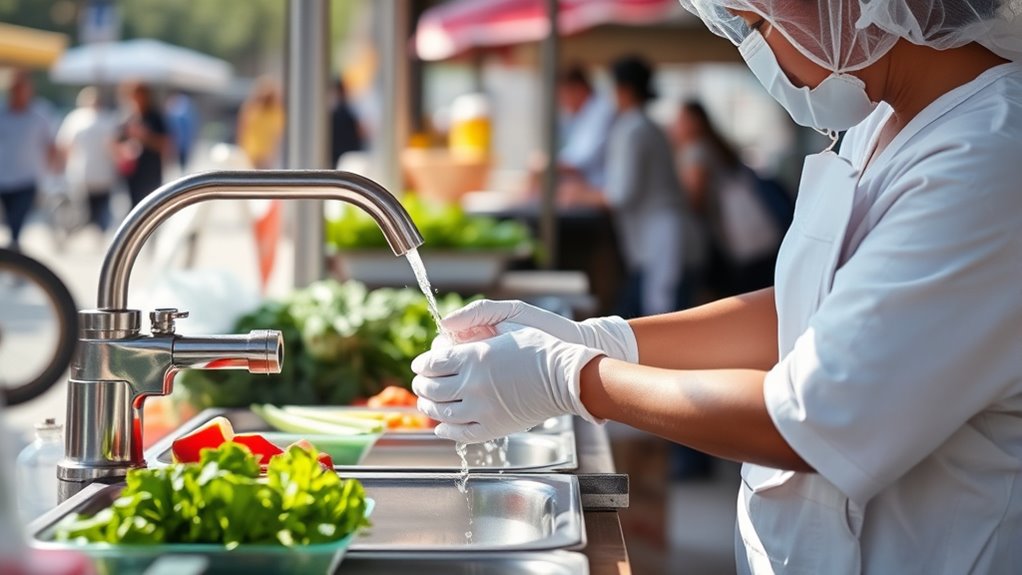
Maintaining proper personal hygiene is essential for guaranteeing food safety. You must follow strict handwashing protocols, washing your hands thoroughly with soap and water before handling food, after touching raw ingredients, or using the restroom. Proper hand hygiene reduces the risk of contamination and prevents foodborne illnesses. Additionally, wearing protective gear, such as gloves, aprons, and hairnets, helps keep your hands and clothing clean. Always change gloves when switching tasks or if they become torn or contaminated. Regularly sanitizing your hands and protective gear ensures cleanliness throughout your work shift. Incorporating food safety guidelines into your routine further emphasizes the importance of maintaining hygiene standards. Proper glove use and protective clothing help prevent cross-contamination effectively. Remember, your commitment to personal hygiene directly impacts the safety of the food you serve, protecting your customers and maintaining your reputation as a responsible vendor. Using proper handwashing techniques can significantly reduce microbial transmission, especially when combined with adequate sanitation practices. Consistent adherence to hygiene protocols is vital for upholding high standards in food handling.
Safe Food Storage Techniques
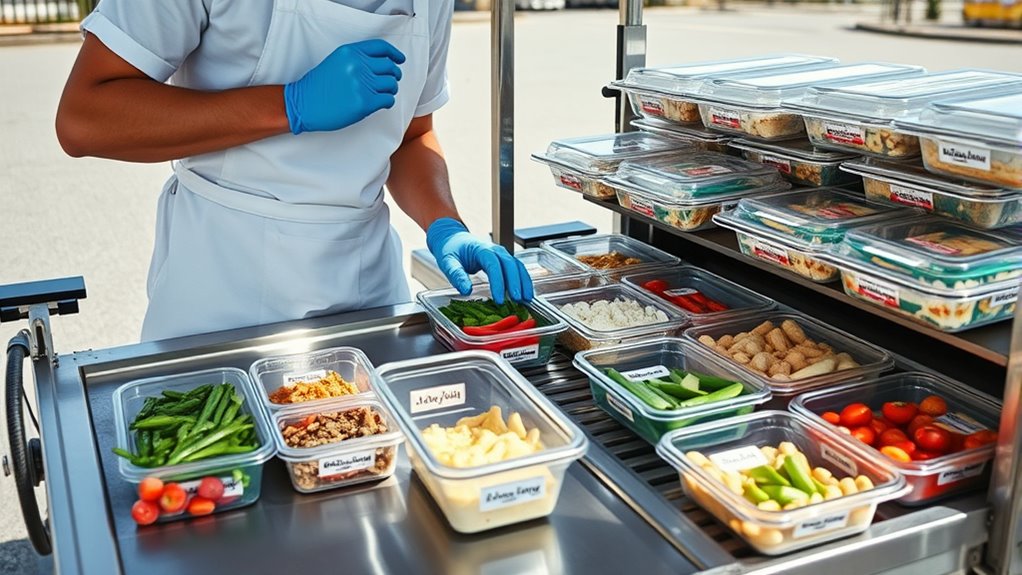
Proper personal hygiene lays the foundation for safe food handling, but even the cleanest hands can’t prevent contamination once food is improperly stored. To keep food safe, focus on using proper storage techniques. Always use clean storage containers that are airtight and labeled correctly for easy identification. Proper food labeling helps prevent cross-contamination and ensures the right items are stored at the correct temperatures. When storing food, keep raw meats separate from ready-to-eat items. Maintain cold foods at 40°F (4°C) or below, and hot foods at 140°F (60°C) or above. Here are key tips:
Proper storage techniques, including labeling and correct temperatures, are essential for food safety and preventing contamination.
- Use food labeling on all storage containers.
- Keep raw and cooked foods separate.
- Store perishable items in refrigerated units.
- Regularly check temperature and container integrity.
Additionally, understanding digital literacy can help ensure proper handling and storage of digital records related to food safety compliance.
Effective Cleaning and Sanitizing Methods
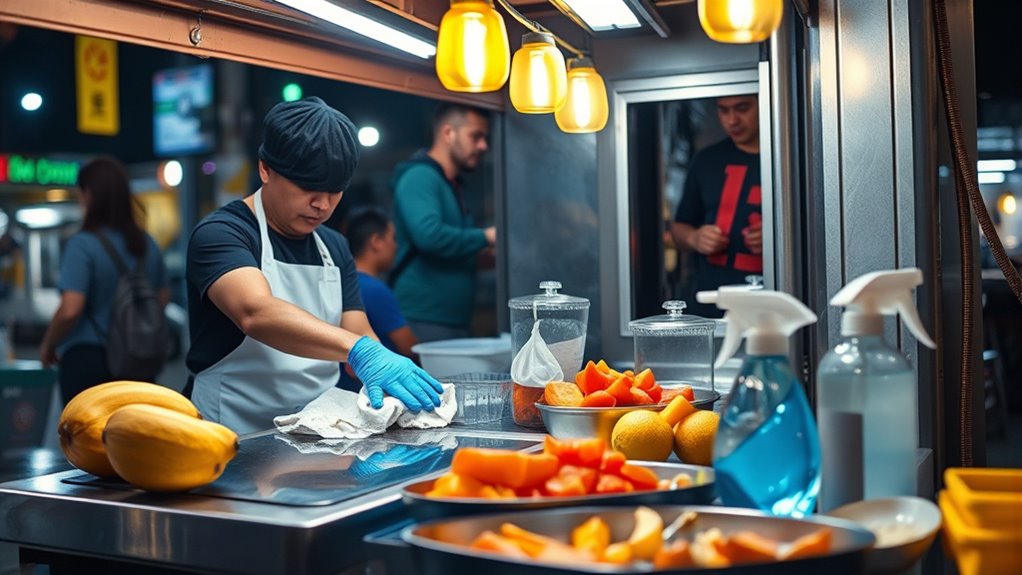
Effective cleaning and sanitizing are essential steps in preventing foodborne illnesses and ensuring a safe food environment. You should follow a strict cleaning schedule routine, focusing on all surfaces and equipment regularly. Use appropriate cleaning agents, and always sanitize after cleaning. Hand sanitizer protocols are crucial; encourage staff to sanitize hands frequently, especially after touching raw ingredients or trash. Maintain a log to track cleaning times and procedures, ensuring consistency. Remember, neglecting proper sanitation can lead to contamination. Here’s a quick overview:
| Step | Frequency | Key Focus |
|---|---|---|
| Surface Cleaning | After each shift and as needed | Countertops, prep areas |
| Equipment Sanitizing | End of day or after use | Knives, cutting boards |
| Hand Hygiene | Before and after handling food | Use hand sanitizer when soap isn’t available |
| Trash Disposal | Daily and as needed | Keep waste away from food prep areas |
Additionally, understanding personal hygiene practices is vital to maintaining a sanitized environment. Regular training on food safety protocols enhances staff awareness and reduces the risk of cross-contamination. Incorporating proper sanitation procedures into daily routines further minimizes the potential for microbial growth and ensures compliance with health standards. Consistent enforcement of these practices is crucial for safety, as neglecting them can compromise the entire food handling process. Implementing hygienic practices consistently helps prevent outbreaks and promotes customer trust.
Handling and Preparing Food Safely
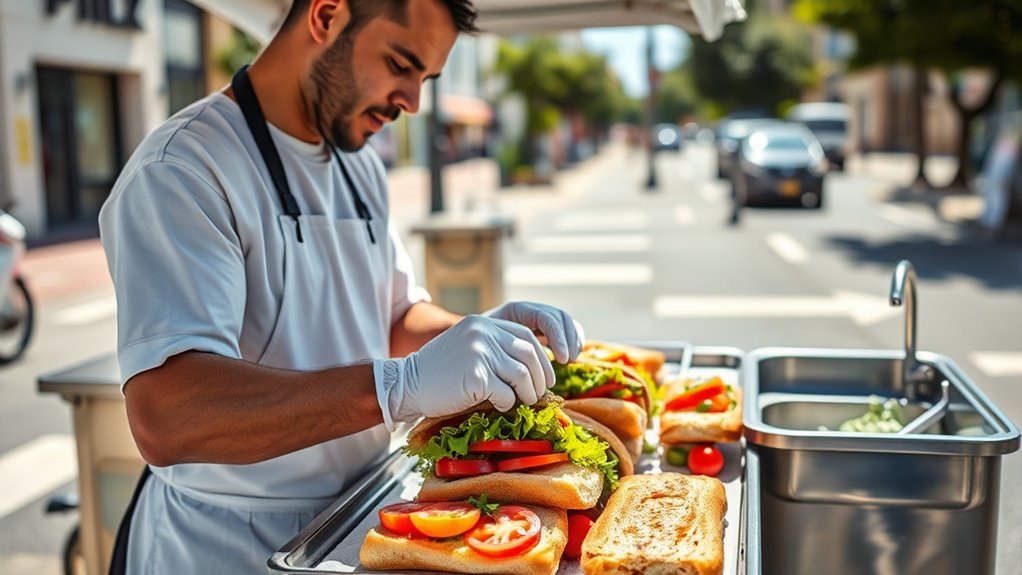
Handling and preparing food safely is essential to prevent cross-contamination and foodborne illnesses. You must stay vigilant and follow proper procedures to protect your customers. Here are key steps to ensure safe handling:
- Wash your hands thoroughly before and after touching different food items.
- Use separate utensils and cutting boards for raw meats and ready-to-eat foods.
- Be aware of food allergy awareness; clearly label allergen-containing items and communicate with customers.
- Practice excellent customer service etiquette by listening carefully to special dietary needs and providing accurate information.
- Stay informed about food safety regulations to ensure compliance and best practices.
- Regularly updating your knowledge on payment processing security can help prevent fraud risks associated with payment transactions.
Maintaining Temperature Control and Cross-Contamination Prevention
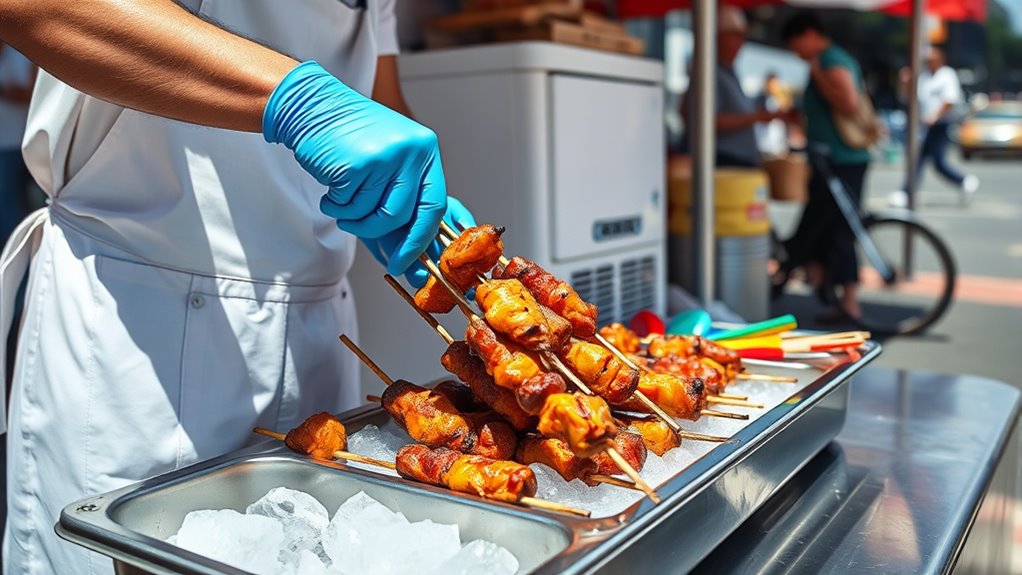
To prevent foodborne illnesses, you need to actively monitor and control temperatures during storage, preparation, and serving. Use a reliable thermometer to guarantee foods stay within safe temperature ranges, avoiding bacterial growth. Regular temperature monitoring helps you catch issues early, keeping your customers safe. To prevent cross contact, always use separate utensils and containers for raw and cooked foods, and clean surfaces thoroughly. Properly storing perishable items at the right temperature is vital. Remember, cross-contamination can happen quickly—staying vigilant minimizes risk. Here’s a quick reminder:
| Food Safety Priority | Action Required |
|---|---|
| Temperature Control | Monitor regularly, keep foods at safe temps |
| Cross-Contact Prevention | Use separate tools, sanitize surfaces |
| Overall Safety | Stay vigilant, prevent contamination |
Consistent temperature management and diligent cross-contamination prevention ensure your food remains safe throughout the entire process. Incorporating AI-driven analysis can further enhance your food safety monitoring efficiency and accuracy.
Frequently Asked Questions
How Should Mobile Vendors Handle Food Allergies and Special Dietary Requests?
When addressing food allergies and special dietary requests, you should prioritize clear allergy communication and dietary accommodation. Always ask customers about allergies upfront, and verify ingredients before preparing meals. Use visible labels or menus to indicate allergen information, and train staff to handle these requests carefully. By actively communicating with customers and accommodating their needs, you guarantee safety and build trust, reducing the risk of allergic reactions and enhancing customer satisfaction.
What Are the Legal Requirements for Mobile Food Vendor Permits and Inspections?
You need to understand permit regulations and inspection processes to operate legally as a mobile food vendor. Obtain the necessary permits from your local health department, ensuring you meet all licensing requirements. Regular inspections verify your compliance with safety standards, food handling, and sanitation laws. Staying up-to-date with permit regulations and passing inspections helps you avoid fines, closures, and legal issues, ensuring your business runs smoothly and safely.
How Can Vendors Prevent Pests and Rodents in Mobile Food Setups?
To prevent pests and rodents, you should implement effective pest control and rodent prevention strategies. Keep your mobile setup clean by promptly disposing of waste and securing trash bins. Regularly inspect for signs of pests, and seal any gaps or holes where rodents could enter. Maintain dry, organized storage, and avoid leaving food scraps exposed. These proactive steps help protect your food and make certain to comply with health standards.
What Are the Best Practices for Waste Disposal and Sanitation on the Go?
You should establish clear waste disposal and sanitation routines. Set up recycling stations nearby to promote eco-friendly practices. Maintain a strict cleaning schedule, regularly sanitizing surfaces and equipment to prevent contamination. Properly dispose of waste promptly to avoid pests and odors. Educate staff on waste management procedures, ensuring everyone follows consistent practices. These steps help keep your mobile setup clean, safe, and compliant with health regulations, enhancing customer trust and satisfaction.
How Should Vendors Manage Food Safety During Peak Busy Hours?
During peak busy hours, you should prioritize food safety by managing your inventory efficiently, maintaining proper temperature controls, and practicing excellent hygiene. Train your staff thoroughly on safety protocols, ensure they handle food properly, and monitor cleanliness continuously. Stay organized, communicate clearly, and stay alert to potential hazards. This combination of inventory management and staff training helps you keep food safe, reduce risks, and serve your customers confidently during the busiest times.
Conclusion
Think of your food cart as a ship sailing smoothly on a busy sea. By following proper hygiene, safe storage, cleaning, and temperature controls, you’re the captain steering clear of storms like contamination and spoilage. Each step you take keeps your vessel afloat and your customers safe and happy. Stay vigilant, and your mobile food business will navigate the waters successfully, earning trust and loyalty like a seasoned sailor mastering the open sea.


